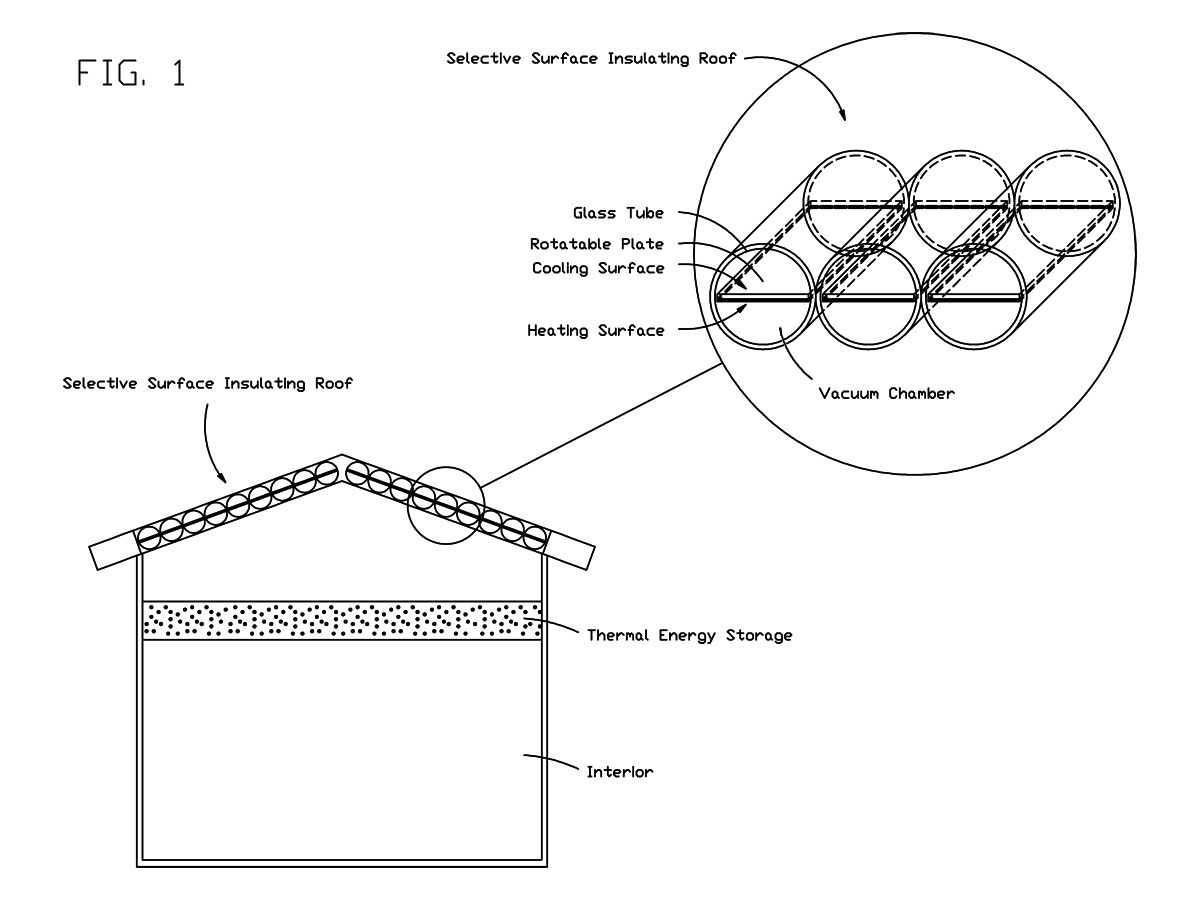

US Regular Utility Patent Application US 17/520,646 filed Nov 6, 2021: USPTO Application US 17/520,646
This disclosure represents a new direction for cooling and heating buildings. This patent application outlines a roof with one or more selective surfaces. It does what has never been done, which is to move heat energy into or out of a building or enclosure to warm and/or cool it while insulating it from conductive loss. What distinguishes this new type of roof from other passive designs is that it works both for heating AND cooling.
The above drawing shows an example that uses a vacuum. However, aerogel with a gas is an alternative embodiment:

Overview
Presently, roofs protect and insulate buildings. Roofs have a surface that faces the sky. As with all surfaces, a roof's surface has radiant properties, and most roofs generally absorb and emit the same amount of radiation in both the visible and infrared ranges. Roofs are dumb devices that cannot modify their behavior to the conditions.
However, a roof's top surface can be a selective surface, which is a surface that has different radiant properties in the different radiant bands and ranges. White roofs have been called for that mostly reflect sunlight in the visible range, yet highly emit radiant heat energy into space in the infrared range. This is a cooling type of selective surface that will cool a building. This can lower AC loads, and help cool the planet. However, it also cools a building in Winter, which will then require more heating. This defeats the purpose. Likewise, a roof with a selective surface that absorbs sunlight, yet emits very little would have the opposite effect. Year long, neither of these two selective surfaces are good solutions. Also, roofs presently need to be insulated, and any positive radiant transfer will overall be countered by negative conduction and radiation losses.
This invention solves these problems by having rotatable selective surfaces, where the correct selective surface can be rotated into view of the sky. It also solves the problem by having the radiant transfer gains outweigh the conductive and convective losses through the roof. The sky comprises two useful heat sources. One is obvious, it is the Sun which radiates warmth. The second, however, is space. Space is a cold source that can be used for cooling. The general problem is that when the Sun is the strongest, its heating will overheat a building. When the Sun is down, then the night sky provides cooling when it is least needed, or detrimental.
The solution is to place the rotatable plates within vacuum chambers within an array of tubes made of glass. Roof tiles can be made of arrays of these tubes. This is similar to vacuum insulated glass windows, which insulate as well as many insulated walls. But the radiant properties of these roof tiles are variable, and adjust to the outside conditions. The rotatable plate controls radiant gain or loss through the vacuum chamber, while the vacuum insulates against conduction loss. (An alternative is to not have a vacuum, but instead to fill the space inside the chambers with a gas, such as air, argon, krypton, etc. This alternative uses aerogel to provide the insulation, while still maintaining the radiant transfer properties through the roof.)
Thus, these roof tiles can move heat into a building on days when it needs to be heated, and they can move heat out of the building on days when it needs to be cooled. However, the greatest heating in Winter is available when the Sun is up, which is usually when it is needed less. Likewise for Summer, the present roof can cool the most at night, when the most cooling is needed during the day. To solve this problem, thermal mass storage (TES) is added to the equation. TES can include phase change materials (PCM). The figure on the right above shows a building with a roof of the present design that can positively transfer radiant heat energy into and out of the depicted building. between the interior space and the roof is placed TES with PCM. PCM changes phase at a constant temperature. If a PCM is chosen that phase changes at the desired indoor temperature, this will moderate the interior temperature to be near constant - even though the amount of heat transferred through the roof varies throughout the course of the day.
The roof described in this application is a smart roof. It can adjust its properties to operate beneficially over a wide range of outdoor conditions. This is a smart passive design, even though, yes, the rotatable plates are actively moved. But the energy to move these plates is inconsequential, and thus it is basically a passive design that uses the free energy of the Sun to heat, and the free heat dissipating cold of deep space to cool.
Many suggestions are contained within the present patent disclosure, and there may be many obvious alternative embodiments. CIP's (Continuation in Part) applications filed with the present inventor listed as a co-inventor are entitled to have the benefit of the present application to overcome obviousness objections. Thus, please contact temple89450 [at] hotmail.com if you would like to work together to move this new invention forward.